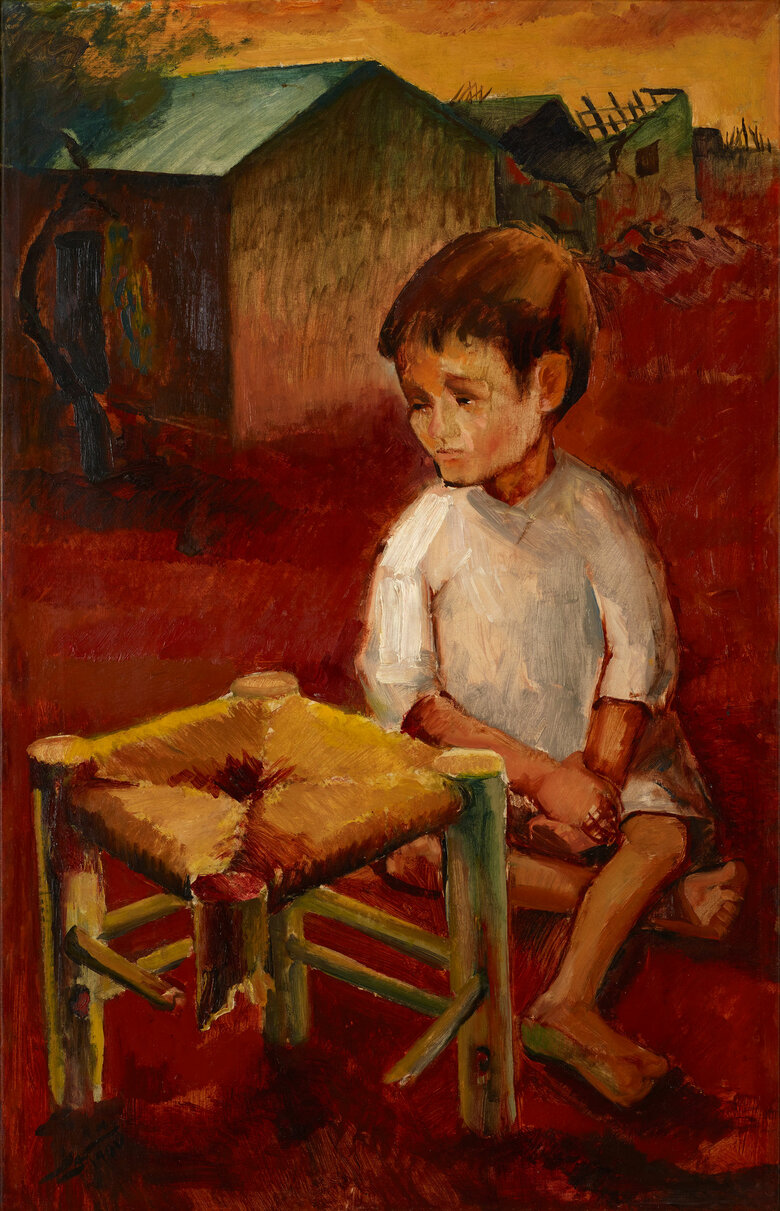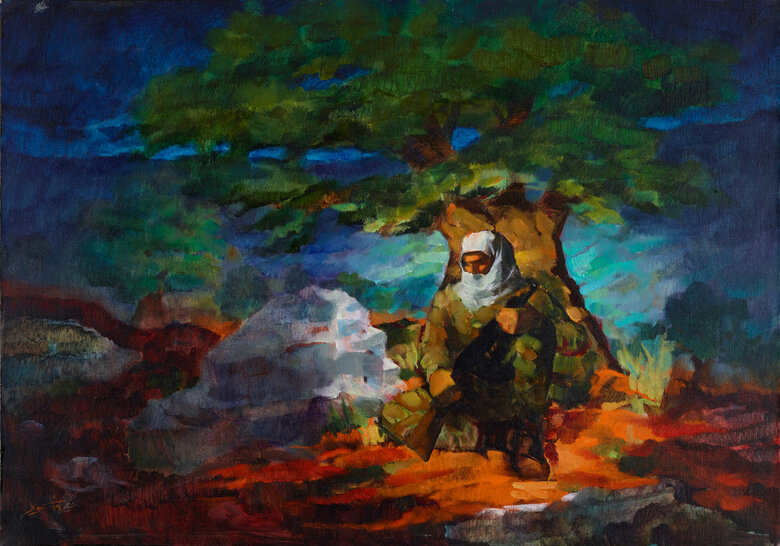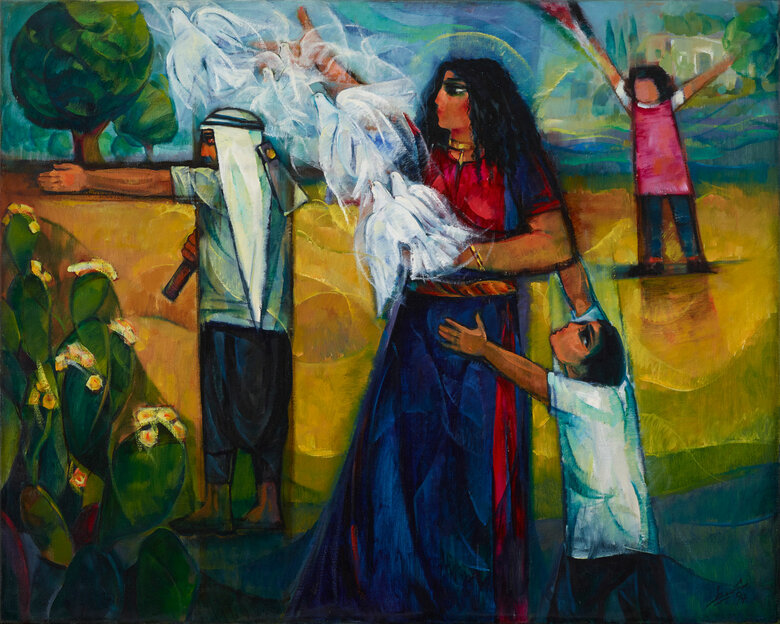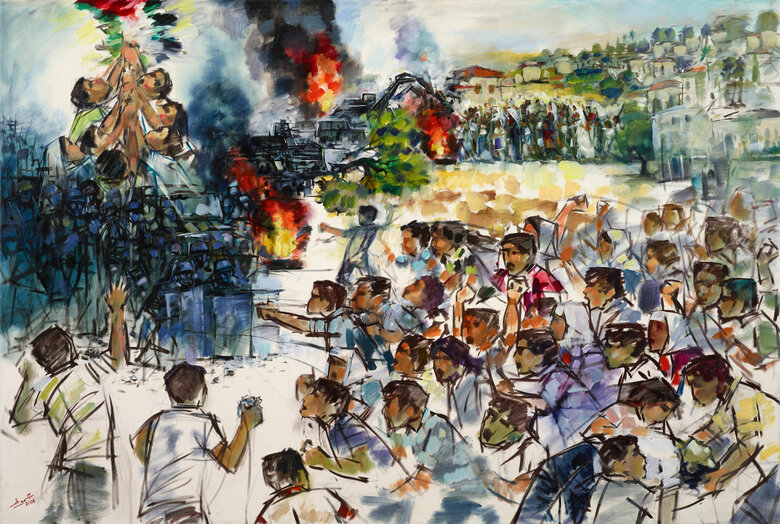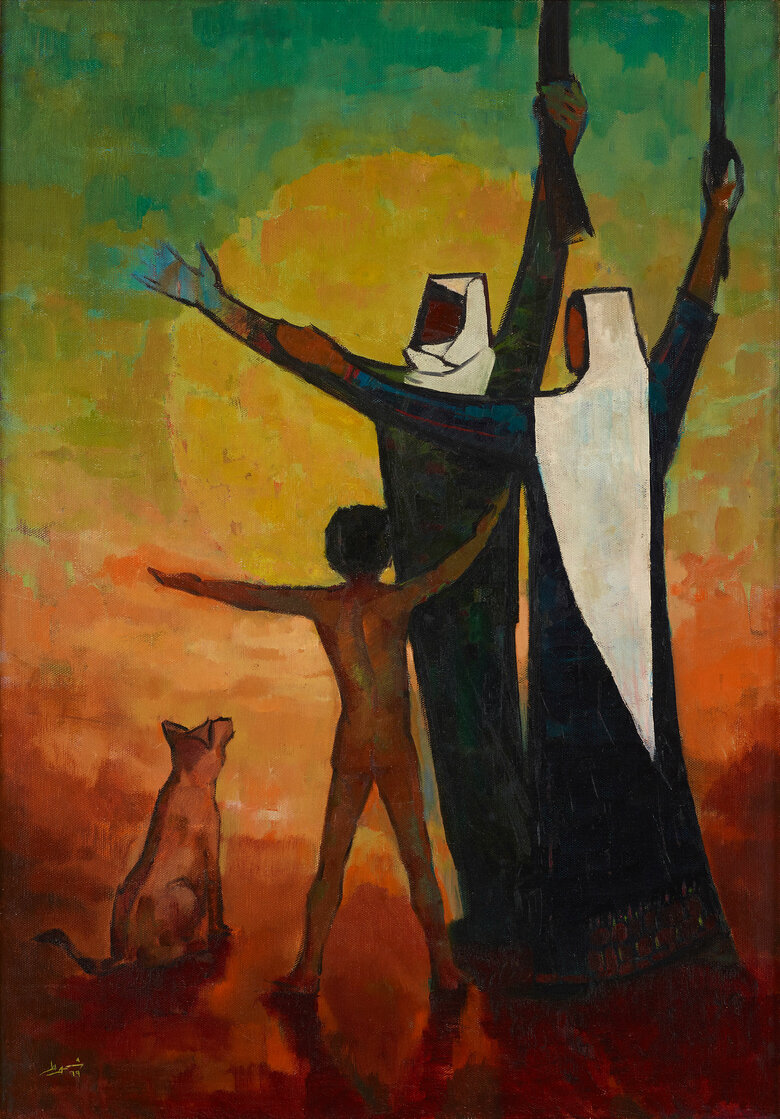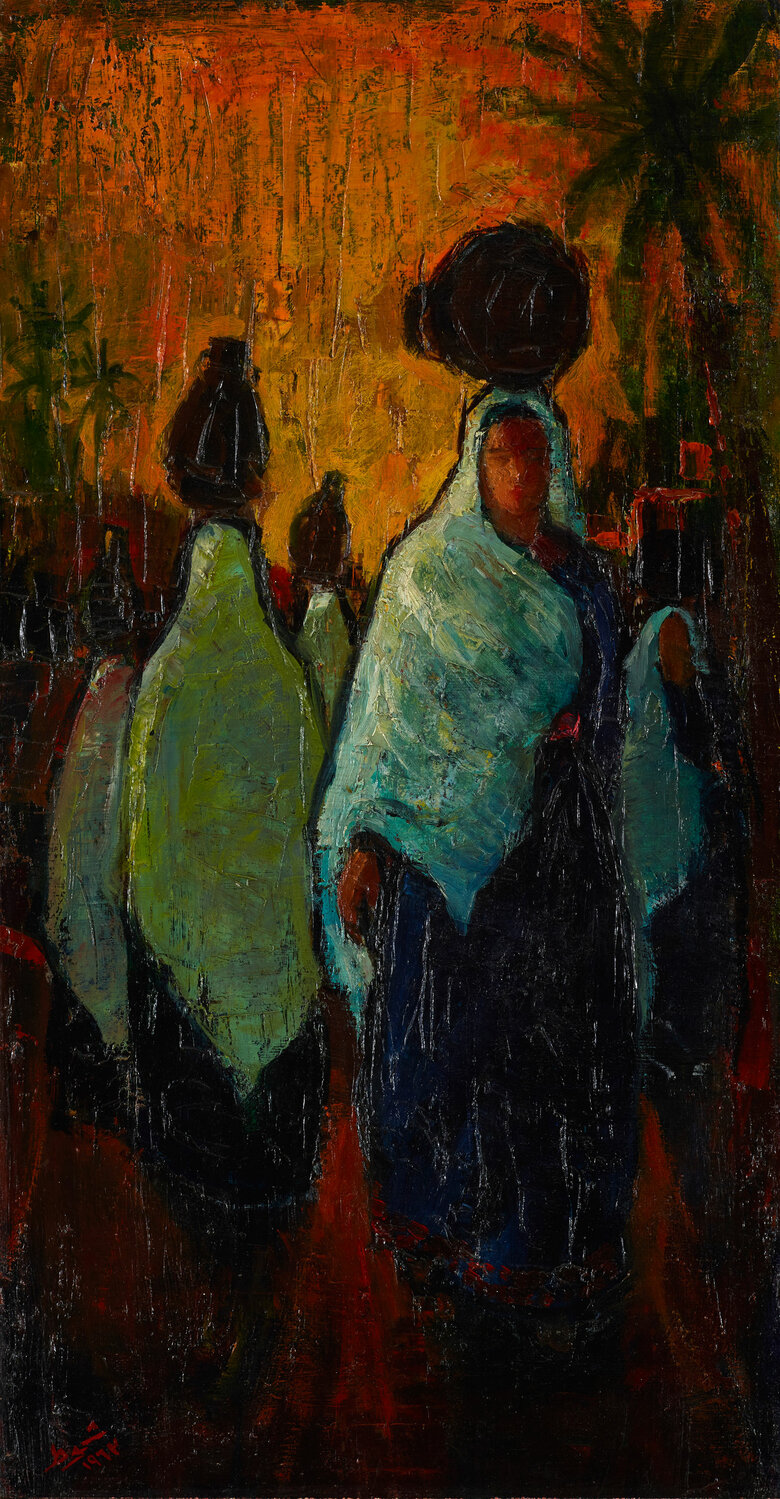Ismail Shammout, a leading figure in modern Palestinian art, was born in 1930 in Lydda, the second of eight children in a working-class family. During his school days in Lydda, he was mentored by...
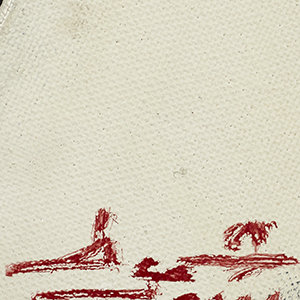

ISMAIL SHAMMOUT, Palestine (1930 - 2006)
Bio
Written by WAFA ROZ
Ismail Shammout, a leading figure in modern Palestinian art, was born in 1930 in Lydda, the second of eight children in a working-class family. During his school days in Lydda, he was mentored by the renowned Jerusalem painter Daoud Zalatimo. Shammout attended the University of Fine Arts in Cairo from 1950 to 1954 and pursued further education at the Academia Di Belle Arti in Rome from 1954 to 1956. Shammout headed the Department of Arts and National Culture of the Palestine Liberation Organization (PLO) from its inception in 1965, and in the late 1960s, he co-founded the Union of Palestinian Artists. He was elected as this union’s Secretary-General in 1969, the same year he established the Dar al-Karama Gallery in Beirut. He became the General Advisor of the Union of Arab Artists in 1971.
Shammout drew inspiration for his nationalistic work from his firsthand experience of the Nakba. In July 1948, Shammout’s hometown of Lydda fell under the Zionist attack, suffering aerial bombardment before becoming the site of one of the Nakba’s deadliest massacres of Palestinian civilians. Zionist troops forced Lydda’s inhabitants to evacuate their homes, and eighteen-year-old Shammout became one of the hundreds coerced into walking what is now known as the “Lydda Death March.”
Ordered at gunpoint to walk miles in the merciless summer heat, Shammout would never forget this gruesome journey, during which his two-year-old brother, Toufic, died of dehydration. This tragic episode inspired Shammout’s first critically acclaimed painting, Where To? (1953).
A terrible two weeks after leaving their home, the Shammouts settled in a refugee camp in Khan Younis, Gaza. In 1950, Ismail took the train from Khan Younis to Cairo to pursue his artistic career. He got a job as an illustrator of Egyptian film posters for an advertising agency, attending college during the day and working through the night. Influenced by his instructors, especially Egyptian modernists Hussein Bicar, Hosni el Banani and Youssef Kamel, as well as his former mentor Daoud Zalatimo, Shammout developed an expressive figurative style through which he transformed his painful experiences into nationalistic iconography. Shammout’s career as a painter began with roughly autobiographical scenes but grew over time to encompass broader allegorical compositions that stirred pro-Palestinian sentiment among his audiences.
In his earliest works, executed in oil on canvas, he portrayed poverty, displacement, and suffering in a realistic style. During this period, in 1953, Shammout mounted his first show in Gaza, exhibiting the iconic Where to? for the benefit of his fellow refugees. The painting featured a drained, yet steadfast, an older man holding his children – or perhaps his grandchildren – tightly as they walk into the unknown. That this painting convincingly communicated the agony of his people was evidenced by the exhibition’s success; the refugees in attendance, many of whom were barely familiar with Western-style easel painting, were deeply moved by the painting, which became an instant symbol of the Palestinian cause.
It was in Cairo, in 1954, that Shammout held his first acclaimed show along with his colleague Tammam El Akhal, whom he married in 1959. This exhibition was pivotal in Shammout’s career, earning him remarkable public recognition and promoting his talents in the cultural capital of Cairo. Gamal Abd al-Nasser inaugurated the show, and Yasser Arafat – then the head of the Union of Palestinian Students –attended it. In 1958, the artist moved to Beirut, where in the 1960s, he became the Director of the Department of Arts and National Culture of the PLO. He designed the PLO’s first logo and produced political posters and pamphlets promoting national resistance. These posters attained an expressive-symbolic style, in line with the ethos of socialist realist art popularized by the cultural regimes of the Eastern Bloc. Art, according to this mindset, should communicate direct messages that are easily understood by people from all backgrounds, helping to unify the proletariat in support of national liberation.
As the Palestinian national resistance grew in the late 1960s and 1970s, Shammout’s narrative paintings reflected determination and optimism. He transformed his previous somber color palette into a vibrant one and replaced the grim figure of the refugee with a young and robust fighter. He also portrayed women, dressed in the traditional Palestinian thobe and adorned with Tatreez, the intricate, brightly-colored embroidery for which Palestinian craftswomen are famous. Drawing from verbal imagery, such as Mahmoud Darwish’s poem Lover from Palestine, Shammout gave visual form to the allegory of Palestine as a female body, defining the peasant woman, with her traditional dress, as the symbol of the homeland. As expressed by Palestinian art historian Tina Sherwell, Palestine came to be represented as both a mother and a virgin, simultaneously nurturing, life-sustaining, and possessed of honor that required defense.
After the Israeli invasion of Lebanon in 1982 and the subsequent expulsion of the PLO, Shammout fled to Kuwait. The Gulf War displaced the artist again in 1991 when he left for Germany and later settled in Amman. In 1997, after nearly fifty years, Shammout and his wife Tammam El Akhal returned to Palestine to visit what was once their home cities, Lydda and Yaffa. Shammout was shocked when he saw his family house inhabited by Israeli citizens.
As an homage to the history of their people, the couple produced a series of nineteen mural-like paintings entitled Palestine: The Exodus and the Odyssey, between 1997 and 2000. Shammout’s contributions, which comprise eleven out of the nineteen, are packed with masses of people on canvas, sketched in scenes that vacillate between utopia and dystopia. The application of paint in swift, vibrant strokes and color gradations lends the canvases a scintillating effect, enhanced by the sharp edges of his fragmented figures. Scenes from Palestinian history overlap in multidimensional compositional narratives, using visual strategies reminiscent of Mexican Muralism. In cinematic succession, Shammout presents a joyful depiction of life in the 1930s, The Spring That Was (1997), followed by the exodus, the struggle, and the resistance, and paying tribute to Palestine’s fallen martyrs. The series concludes with The Dream of Tomorrow (2000), a hopeful image that portrays children flocking to a benevolent Mother Palestine, gathering flowers and fruits for her as birds fly freely overhead.
Shammout Passed away in Amman in 2006, having left an indelible mark on Palestinian art history.
Sources
Boullata, Kamal. Palestinian Art, 2005-1850. London: Saqi, 2009.
Ankori, Gannit. Palestinian Art. London: Reaktion Books, 2006.
«Imaging Palestine as the Motherland - Hagar Art Gallery. » Accessed September 2018 ,20. http://www.hagar-gallery.com/Catalogues/Self_Portrait_01_03.pdf
Bostonpalestinefilmfest.org. Accessed December 07, 2018. http://www.bostonpalestinefilmfest.org/festival/schedule/.
"Biography." Biography - Ismail Shammout. Accessed December 7, 2018. http://www.ismail-shammout.com/cms/biography.html.
Aderet, Ofer. "Why Are Countless Palestinian Photos and Films Buried in Israeli Archives?" Haaretz.com. April 24, 2018. Accessed December 07, 2018. https://www.haaretz.com/israel-news/.premium.MAGAZINE-why-are-palestinian-photos-and-films-buried-in-israeli-archives-1.5490325.
Archive, Asia Art. "17 Lost Art Exhibitions." Search | Kwok in Beijing | Asia Art Archive. Accessed December 07, 2018. https://aaa.org.hk/en/ideas/ideas/17-lost-art-exhibitions.
ArteEast, Inc.- Http://www.arteeast.org/. "ArteEast." Razor Tie Artery Foundation Announce New Joint Venture Recordings | Razor & Tie. Accessed December 07, 2018. https://web.archive.org/web/20110722013841/http://www.arteeast.org/pages/artenews/article/30.
Blincoe, Nicholas. "When Artists Go to War: Inside the PLO's Information Department." The Guardian. May 13, 2014. Accessed December 07, 2018. https://www.theguardian.com/artanddesign/2014/may/13/plo-palestine-art-the-world-is-with-us.
"Lasting Impressions: Ismail Shammout and Tamam El-Akhal." Sharjah Museums. Accessed December 07, 2018.http://sharjahmuseums.ae/Events/Lasting-Impressions-Ismail-Shammout-and-Tamam-El-A.aspx?lang=en-US.
"Looted from Beirut 35 Years Ago, Now on Display in Tel Aviv." 972 Magazine. December 04, 2017. Accessed December 07, 2018. https://972mag.com/looted-from-beirut-35-years-ago-now-on-display-in-tel-aviv/131187/.
Murphy, Maureen Clare. "In Remembrance: Ismail Shammout, 1931-2006." The Electronic Intifada. February 12, 2017. Accessed December 07, 2018. https://electronicintifada.net/content/remembrance-ismail-shammout-1931-2006/6067.
Palestinian, Uprooted. "Uprooted Palestinian." Popular UK Textbook Erases Israel From Map. January 01, 1970. Accessed December 07, 2018. http://uprootedpalestinians.blogspot.com/2010/03/ismail-shammout-paints-palestinian.html.
Person. "5 Minutes With... Ismail Shammout's Odyssey of a People | Christie's." Albrecht Dürer: 10 Things to Know | Christie's. March 08, 2017. Accessed December 07, 2018. https://www.christies.com/features/Masa-Al-Kutoubi-with-a-painting-by-Palestinian-Ismail-Shammout-8121-1.aspx.
"Ramallah: Seminar and Exhibition on the Life and Work of Ismael Shammout." A M Qattan Foundation. February 19, 2018. Accessed December 07, 2018. http://qattanfoundation.org/en/qattan/media/news/ramallah-seminar-and-exhibition-life-and-work-ismael-shammout.
Wilson-Goldie, Kaelen. "Couple's Paintings Evoke Mythology of Palestine." The Daily Star Newspaper - Lebanon. Accessed December 07, 2018. http://www.dailystar.com.lb/Culture/Art/2003/Oct-09/112392-couples-paintings-evoke-mythology-of-palestine.ashx.
CV
Selected Group Exhibitions
2023
In Solidarity with Palestine, Darat al Funun, Amman, Jordan
The Little Prince of Gaza, Dalloul Art Foundation (DAF), Beirut, Lebanon
2019
A century in flux: highlights from the barjeel art foundation: chapter II, Sharjah Art Museum, Barjeel Art Foundation, Sharjah, UAE
Notes on Solidarity: Tricontinentallsm in Print, James Gallery, Center for the Humanities, Midtown, New York, USA
2018
Lasting Impressions: Ismail Shammout & Tammam El-Akhal, Sharjah Art Museum Annual Exhibition, Sharjah, UAE
Keyword- Palestine, Dar El-Nimer for Arts and Culture, Beirut, Lebanon
2017
A Sight of Disjunction, Dar Sa’a, Old city of Ramallah, Palestine
2016
The Short Century,Sharjah Art Museum, Barjeel Art Foundation, Sharjah, UAE
Unlike Other Springs, Birzeit University Museum, Birzeit, Palestinian territories
2014
The World is with Us: Global Film and Poster Art from Palestinian Revolution,1968-1980, London, UK
2003
Palestine: The Exodus and the Odyssey, Tourism Ministry Glass Hall, Beirut, Lebanon
1984
Exposition d' Art Contemporain Arabe, Centre d’Art Vivant de la ville de Tunis, Tunisia
1982
Exhibition at Dar Al-Karama Gallery, Beirut, Lebanon
1979
Palestinian Exhibition in Moscow, Moscow, Russia
1954
Palestine Exhibition, Cairo, Egypt
1953
Where To?, Gaza, Palestine
Publications
2011
Ismail Shammout Award for contemporary artist painters
1989
Art in Palestine, Kuwait , Arabic & English.
1978
Palestine in Perspective, Beirut , Arabic & English.
Palestinian National Art, Beirut various languages.
1972
Palestine, Illustrated Political History, various languages.
1957
The Young Artist, Beirut, Arabic.
Collections
Barjeel Art Foundation, Sharjah, UAE
Sharjah Art Museum, Sharjah, UAE
Ramzi and Saeda Dalloul Art Foundation (DAF), Beirut, Lebanon
Dar El Nimr, Beirut, Lebanon
Jordan National Gallery of Fine Arts, Amman, Jordan
The Birzeit University collection, Ramallah, Occupied Palestine
Shammout Family private Collection, Amman, Jordan
Press
Al Masri Al Youm.pdf
جريدة الغد.pdf
طباعة - إسماعيل شموط وتمام الأكحل_ أثر الفن والسيرة.pdf
ذكرى رحيل الفنان اسماعيل عبد القادر شموط - من الذاكرة الفلسطينية.pdf
دار الكلمة الجامعية تطلق مسابقة جائزة الفنان اسماعيل شمّوط.pdf
الجزيرة.نت.pdf
IsmailShammout_Ismail Shammout’s Odyssey of a People to be sold for the first time - News, #Art, Christie_s, Ismail Shammout, Auction, Palestine _ Harper_s BAZAAR Arabia_Press.pdf
IsmailShammmout_In remembrance_ Ismail Shammout, 1931-2006 _ The Electronic Intifada_Press.pdf
» Honour Ismail Shammout 1930-2006_Beloved Artist of Palestinian self-determination– IMEMC News.pdf
في الذكرى السابعة لغياب الفنان إسماعيل شموط_ بائع الحلوى الذي اصبح رسام فلسطين نضال القاسم » Print القدس العربي Alquds Newspaper.pdf
رحلات فلسطينية إسماعيل شموط.pdf
الحياة - 14 فناناً فلسطينياً من أجيال مختلفة في معرض محوره إسماعيل شموط وتمام الأكحل.pdf
Bank of Palestine - News.pdf
In remembrance_ Ismail Shammout, 1931-2006 The Electronic Intifada.pdf
أوراق خاصة من حياة الفنان التشكيلي الفلسطيني إسماعيل شموط - مؤسسة فلسطين للثقافة.pdf
Beginning of the Tragedy-IsmailShammout.pdf
Masa Al-Kutoubi with a contemporary Palestinian work Christie_s.pdf
إسماعيل شموط.. يده هي التي ترى وقلبه هو الذي يرسم.pdf
One Fine Art artists - painters _ ismail abdul qader shammout.pdf
Obituary_ Ismail Shammout (1930-2006) – Artist, Activist, Legend.pdf
Gaza_s artists under fire The Electronic Intifada.pdf
Haithem El-Zabri The Electronic Intifada.pdf
p-Gaza_s artists under fire The Electronic Intifada.pdf
MR Online Under the Voices of Fire_ Artists in Gaza.pdf
p-One Fine Art artists - painters _ ismail abdul qader shammout.pdf
p-Meeting Israelis for the first time, Palestinians ask_ How do you feel living in our homes - Palestinians - Haaretz.com.pdf
r-Meeting Israelis for the first time, Palestinians ask_ How do you feel living in our homes - Palestinians - Haaretz.com.pdf
ISMAIL SHAMMOUT Artwork
Become a Member
Join us in our endless discovery of modern and contemporary Arab art
Become a Member
Get updates from DAF
Follow Artists
Save your favourite Artworks
Share your perspectives on Artworks
Be part of our community
It's Free!
We value your privacy
TermsCookiesPrivacy Policies
Become a Member
Get updates from DAF
Follow Artists
Save your favourite Artworks
Share your perspectives on Artworks
Be part of our community
It's Free!
We value your privacy
TermsCookiesPrivacy Policies
Become a Member
Get updates from DAF
Follow Artists
Save your favourite Artworks
Share your perspectives on Artworks
Be part of our community
It's Free!
We value your privacy
TermsCookiesPrivacy Policies
Welcome to the Dalloul Art Foundation
Thank you for joining our community
If you have entered your email to become a member of the Dalloul Art Foundation, please click the button below to confirm your email and agree to our Terms, Cookie & Privacy policies.
We value your privacy, see how
Become a Member
Get updates from DAF
Follow Artists
Save your favourite Artworks
Share your perspectives on Artworks
Be part of our community
It's Free!
We value your privacy
TermsCookiesPrivacy Policies

-Front-edited.jpg)
-Front-edited.jpg)
